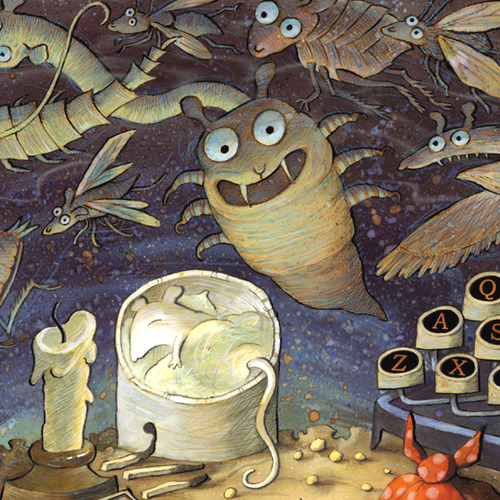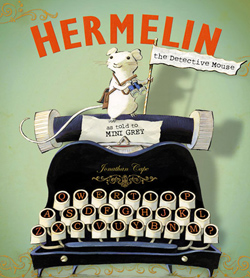< Back to posts
Mini Grey
United Kingdom

Mini Grey was born in a Mini in Newport, Wales. After working as a theatre designer and a primary school teacher, she took a Masters in Sequential Illustration at Brighton University. She’s since created many successful picturebooks including ‘The Adventures of the Dish and the Spoon’, which won the CILIP Kate Greenaway Medal.
In this post, Mini shares some wonderful development work and stunning illustrations from ‘Hermelin: The Detective Mouse’. This picturebook was quite a challenge for Mini to create, and she talks here about how she solved the mystery of the story.
Mini: As a child I tried to make something every day. I very much liked the world of the tiny – in fact we had a box in our toy cupboard that was just called SMALL THINGS. At one point I desperately wanted a mouse for a pet, and made my own mouse out of fur fabric and kept it in a cardboard box, though it never really fulfilled my pet-expectations.
I watched absolutely mountains of television as a child. I loved the films of Oliver Postgate and Peter Firmin – especially the ‘Clangers’. I loved the home-made knitted look of the Clangers, and the charming mystery of their life on a strange planet where you could grow your own music on trees and get blue string pudding from soup dragons.
Anyway, what I’m going to tell you here is about the making of my book, ‘Hermelin: the Detective Mouse’, and it’s a long and meandering tale that takes place over quite a few years.
Our story starts with a lost pet and a cheese box.
Here’s the lost pet:
The lost pet was our cat, Bonzo. We’d moved house and not installed a cat flap, and one night he went out of the window and didn’t come back. We put up posters for Bonzo on every lamp post, we searched the neighbourhood, we called for our cat high and low. But I couldn’t help noticing there were quite a lot of lost cat posters appearing on our local community noticeboard. Where were the cats going to? What if there was a mystery to investigate here?
The cheese box was this one. It came from Prague; the cheese inside was a sort of Camembert. I didn’t much like the cheese, but I really liked the box. Who might find themselves inside a cheesily-scented box like this?
It really had to be a mouse.
Now it seemed to me a mouse would make a perfect DETECTIVE or SECRET AGENT or OBSERVER, because it could travel incognito through drain holes and sewer pipes and gutters and cavities and tunnels – from rooftop to underground. It could get into kitchens and attics and all around a neighbourhood. Mice have special abilities; mice can drop huge distances without being hurt because they are SMALL.
Here is J.B.S. Haldane from ‘On Being the Right Size’: “You can drop a mouse down a thousand-yard mine-shaft; and, on arriving at the bottom, it gets a slight shock and walks away. A rat is killed, a man is broken, a horse splashes.”
Mice also love rubbish, and nibbling, and to be near people... However, people don’t like mice and usually want to EXTERMINATE them. In fact the word mouse comes from mus: ‘to steal, rob’.
Some mouse crime:
So there’s a terrible existential predicament in being a mouse.
I decided Hermelin was going to be a white mouse who wakes up in a cheese box, and discovers he can read. And there could be so many things to read: bits of newspaper, advertisements, cornflakes packets, crisp packets, milk and juice cartons, postcards, notes, posters...
Maybe a whole community noticeboard full of clues... (I’d seen the film ‘The Usual Suspects’, where at the end you discover the whole story has been constructed by Kevin Spacey’s character from the ephemeral fragments in front of him on a police noticeboard).
I made a few Suspicious Objects:
I made a picture of a mouse at a typewriter. Was this a way my mouse detective could communicate with a whole neighbourhood?
And if he left notes, no-one would know he was a mouse. (And here I must owe a debt to the marvellous ‘Anatole’ by Eve Titus which I had loved as a child.) An inspirational book was Graham Rawle’s ‘Diary of an Amateur Photographer’, which is a facsimile casebook of typed notes and found fragments.
Sketchbook – first ideas:
I needed to collect ingredients for this story; here are some little brainstorm pictures of situations Hermelin might find himself in:
Telling the story – we’d need the voice of Hermelin typing on his typewriter. I tried putting words with the pictures – trying out a bit of typewriting voiceover (in the sketch page below I haven’t realised yet that I need to be typing in Hermelin’s voice – d’oh!):
But I just couldn’t work out what was happening to the cats.
The secret truth is – although I really wanted it to be about the lost cats, I couldn’t solve the lost cats mystery. Here are a few of the ideas that just didn’t work:
So I was stuck with the lost cats – and then despite wonderful suggestions, support and help from my editor, Helen MacKenzie Smith, I just had to put the whole thing aside.
AT THIS POINT SEVERAL YEARS GO BY...
Then my next editors, Sue Buswell and Andrea MacDonald saw the Hermelin rough book again and thought perhaps it wasn’t so far away... if we could just put those cats aside, and make Hermelin’s journey from would-be detective to mouse-pest and back again the focus of the story.
Here’s some Hermelin storyboard sketches:
And some mice:
Often at the end of my favourite picture books you feel you’ve really been somewhere else. This story, to bring you into Hermelin’s world, seemed to need a real tangible sort of environment; there seemed to need to be a bit of a realistic setting to tell this story, maybe so that a mouse who can read is an unusual thing. The pictures were going to be cluttered with layers of readable stuff; loads of notes, messages, sweet wrappers and found items and general printed detritus.
Making the pictures: these are mostly painted in Quink and watercolour on heavyweight ordinary paper, with ink and coloured pencil on top. I used masking fluid quite a lot so I could splatter backgrounds or do messy washes. Then I scanned them into my computer and added textures and patterns I’d found. There were lots of readable fragments to make as overlays. Big shadows I added as transparent layers.
Here’s the opening in Offley Street; everyone is in the act of losing something:
Here’s Hermelin’s attic; he’s reading a bit of Sherlock Holmes:
Hermelin is horrified to discover he’s a pest. Here he has been sucked into an encyclopedia page, full of information on how to exterminate mice:
Later, as he sleeps, Hermelin is haunted by nightmares of mouse-pest creatures:
Here is Emily finding him in the attic:
ENDBIT:
So this story started with a lost cat. It might have to end with a lost cat.
2½ years after he’d disappeared, we got Bonzo back again. He was found living in a bush and taken to a vet who discovered the microchip which we’d had put in. Bonzo was just the same and as friendly as ever, except there was a bite-shaped chunk missing from one of his ears. We were overjoyed to have our pet back – though his sister Bonzetta didn’t seem so happy about it. He stayed with us for a few months but then we went on holiday leaving a neighbour to feed the cats, and when we returned, Bonzo had gone again. We haven’t seen him since, but we know he is a very friendly cat.
We still do have Bonzetta though, who likes to eat cream...
and who I suspect may have a secret job.
Illustrations © Mini Grey.
Hermelin: The Detective Mouse
Mini Grey
Jonathan Cape (Random House), United Kingdom, 2014
Hermelin is a noticer. He is also a finder. The occupants of Offley Street are delighted when their missing items are found, but not so happy to learn that their brilliant detective is a mouse! What will happen to Hermelin? Will his talents go unrewarded?
‘Grey brings her hilarious, cartoonish-yet-artful Traction Man sensibilities to this winsome story of the importance of transcending stereotypes...’ —Kirkus Reviews

























